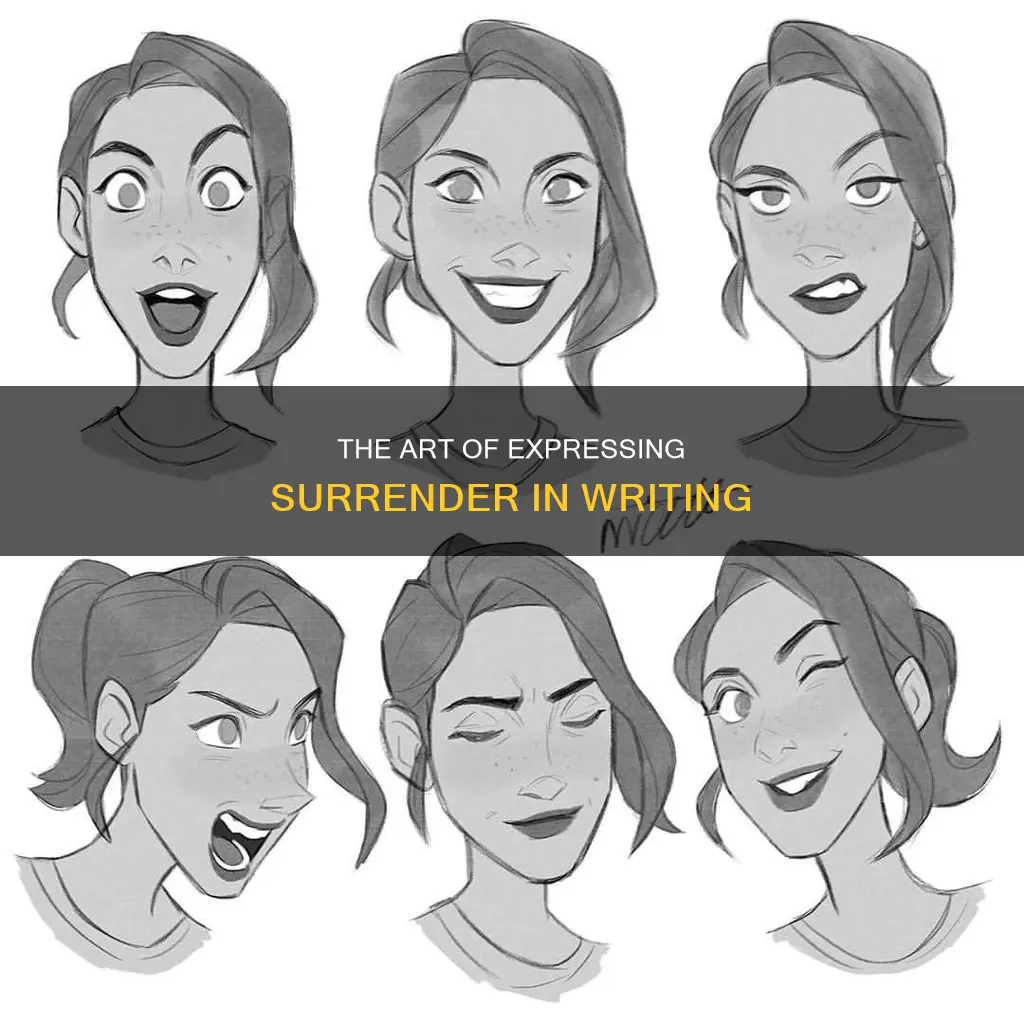
Imagine a powerful story where the protagonist finds themselves trapped in a web of impossible challenges, unable to find a way out. As they grapple with their desperation and exhausted determination, a new emotion emerges - surrender. It is in this delicate moment that the protagonist's true strength and resilience are laid bare, showcasing the immense power surrender can hold in a narrative. In writing, capturing surrender becomes an artful dance that immerses readers in the depths of human emotion, evoking empathy and creating a captivating story.
| Characteristics | Values |
|---|---|
| Tone | Resigned, defeated |
| Language | Passive, downtrodden |
| Sentence structure | Simple, fragmented |
| Emotion word | Surrender, give up |
| Imagery | Dark, hopeless |
| Metaphors | Sinking ship, wilting flower |
| Symbols | White flag, empty hands |
| Body language | Slumped shoulders, bowed head |
| Repetition | Phrases like "I give in" or "I can't do it anymore" |
What You'll Learn

How to Show the Emotion Surrender in Writing
Surrender is a powerful, complex emotion that can evoke a myriad of feelings within readers. When writing a story or a piece of fiction that revolves around surrender, it is essential to communicate this emotion effectively. By using descriptive language, incorporating physical gestures, creating vulnerable dialogue, and employing symbolism and imagery, you can transport your readers into the heart and mind of your characters experiencing surrender.
Using Descriptive Language:
Descriptive language plays a vital role in capturing the essence of surrender. By painting vivid images with your words, you can evoke strong emotions in your readers. Describe the physical sensations that characterizes surrender, such as trembling hands or a racing heart. For example, you could write, "Her hands shook as she released her grip, her heart pounded against her ribcage."
Additionally, use visual descriptions to convey the atmosphere of surrender. Describe the surroundings in a way that aligns with the character's emotional state. For instance, you might write, "The room felt suffocating, as if the walls were closing in on her, mirroring the weight of her surrender."
Incorporating Physical Gestures:
Gestures can be powerful tools for conveying surrender. Use body language to demonstrate the character's inner turmoil. For instance, describe their shoulders slumping, their head bowing, or their body going limp. These physical cues can create a strong visual impact, allowing the readers to empathize with the character's surrender.
Additionally, consider incorporating motions that symbolize surrender. Perhaps the character's hands tremble as they release a tightly clutched object, or they extend their arms, palms up, as if relinquishing control. These gestures can add depth and meaning to the scene.
Creating Vulnerable Dialogue:
Dialogue is an excellent way to showcase surrender, as it allows readers to witness the character's inner thoughts and emotional vulnerability. Craft dialogue that reveals the character's surrender through their words. Use hesitant or trembling speech patterns to showcase their uncertainty or fear.
Additionally, explore the character's internal conflicts through dialogue. Have them express conflicting emotions, showcasing the struggle between resistance and surrender. For example, you might write, "I don't want to give up, but I can't keep fighting anymore. It's draining me."
Employing Symbolism and Imagery:
Symbolism and imagery can provide a deeper layer of meaning when portraying surrender in writing. Consider using objects or situations that symbolize surrender, such as a white flag or a sinking ship. These symbols can enhance the emotional impact of the scene and add depth to your writing.
Additionally, use rich and evocative imagery to convey the character's surrender. Utilize metaphors and similes to bring the emotion to life. For example, you could write, "Her surrender was like a tidal wave, washing over her and erasing all traces of resistance."
In conclusion, when writing about surrender, it is crucial to engage your readers and make them feel the depth of emotion experienced by your characters. By using descriptive language, incorporating physical gestures, creating vulnerable dialogue, and employing symbolism and imagery, you can effectively convey surrender in your writing. Experiment with these techniques to add depth and realism to your characters' emotional journeys, and watch as your readers become fully immersed in the world of surrender.
The Emotional Spectrum: Exploring the Irish Stigma of Reserve vs. Expressiveness
You may want to see also
Frequently asked questions
When you want to convey the emotion of surrender in your writing, you can use descriptive language to depict the physical and emotional sensations that come with surrendering. For example, you can describe the characters' body language, such as slumping shoulders or lowered gaze, to show their submission. Additionally, you can use words like "resignation," "acceptance," or "yielding" to explicitly convey the surrendering of control or power.
Dialogue can be an effective tool for showing surrender in writing. To portray surrender through dialogue, you can have the characters use phrases or language that demonstrate their resignation or acceptance of a situation. For instance, they might say things like, "I give up," "You win," or "I have no choice." Additionally, you can have the characters speak in a quieter or more defeated tone to convey their surrender.
In addition to using physical descriptions and dialogue, you can also use internal thoughts and reflections to reveal the emotion of surrender. By showing the characters' internal struggle and decision to surrender, you provide deeper insight into their emotional state. This can be achieved through introspective paragraphs or inner monologues where the characters reflect on their circumstances and ultimately choose to surrender.







